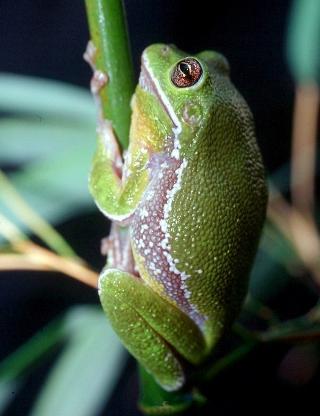


|
Hylidae :
These are the tree frogs, a wide-spread family especially well represented in the New World. Hylids range from small to large in size and usually have distinct adhesive toe discs that contain a cartilage that offsets the terminal phalanx, which may aid in climbing. Many reproductive modes are found in this family. Hylidae is one of the largest families of anurans with 48 genera and over 800 species recognized. It now includes two genera, Lysapsus and Pseudis, that have been placed in a separate family Pseudidae by some authors. Until recently the Hylidae was partitioned into 4 subfamilies, but a major revisionary study by Faivovich, Haddad, Garcia, Frost, Campbell and Wheeler (2005, Bull. Amer. Mus. Nat. Hist.) removed all species of the subfamily Hemiphractinae (Cryptobatrachus, Flectonotus, Gastrotheca, Hemiphractus, and Stefania) from the Hylidae and placed them tentatively in the Leptodactylidae. The currently recognized subfamilies are: Pelodryadinae (Australian/Papua New Guinean treefrogs) contains the curious Cyclorana platycephala (known as the Water holding Frog) which is found by the Aboriginies and squeezed for the water in its bladder. Represented by 160+ species in 3 genera (Cyclorana, Litoria, and Nyctimystes) Phyllomedusinae (highly arboreal leaf frogs). Comprised of 50 species in 7 genera (Agalychnis,Cruziohyla, Hylomantis, Pachymedusa, Phasmahyla, Phrynomedusa, and Phyllomedusa) distributed in from Mexico through Central and South America. Two famous members of this group are the Waxy-Monkey treefrog (Phyllomedusa bicolor) which is adapted for arid regions, and the Red-eyed Treefrog (Agalychnis callidryas). They tend to lay eggs on plants and have their larvae fall into water, but some breed in tree/log cavities. Hylinae is the subfamily with the widest distribution (North, Central, and South America, Eurasia and North Africa). The recent revision of this subfamily by Faivovich et al. recognizes 4 tribes and 45 genera, many newly named. There are nearly 200 species. Only the genus Hyla is found outside of the New World. Frogs in this large clade have claw-shaped terminal phalanges (also convergent with some Hyperoliids).
Genus :
Acris (2 species)
Agalychnis (6 species)
Anotheca (1 species)
Aparasphenodon (3 species)
Aplastodiscus (15 species)
Argenteohyla (1 species)
Bokermannohyla (26 species)
Bromeliohyla (2 species)
Charaidrahyla (5 species)
Corythomantis (1 species)
Cruziohyla (2 species)
Cyclorana (13 species)
Dendropsophus (95 species)
Duellmanohyla (8 species)
Ecnomiohyla (10 species)
Exerodonta (11 species)
Hyla (32 species)
Hylomantis (8 species)
Hyloscirtus (30 species)
Hypsiboas (76 species)
Isthmohyla (14 species)
Itapotihyla (1 species)
Litoria (140 species)
Lysapsus (3 species)
Megastomatohyla (4 species)
Myersiohyla (4 species)
Nyctimantis (1 species)
Nyctimystes (24 species)
Osteocephalus (18 species)
Osteopilus (9 species)
Pachymedusa (1 species)
Phasmahyla (4 species)
Phrynomedusa (5 species)
Phyllodytes (11 species)
Phyllomedusa (30 species)
Plectrohyla (42 species)
Pseudacris (14 species)
Pseudis (6 species)
Ptychohyla (13 species)
Scarthyla (2 species)
Scinax (91 species)
Smilisca (8 species)
Sphaenorhynchus (11 species)
Tepuihyla (8 species)
Tlalocohyla (4 species)
Trachycephalus (10 species)
Triprion (2 species)
Xenohyla (2 species) |
